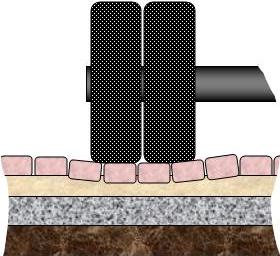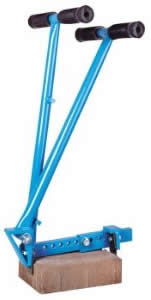- Heaving or sinking of paving bricks or concrete stones.
- The original base for the paving stones was not installed properly. In many cases it is the result of not compacting the base evenly or with enough weight. This can be corrected by removing the paving stones that are not level adding some additional base material and compacting it properly.
- In Northern climates it is possible that water got underneath the paving bricks, and prior to draining froze and lifted the bricks out of position. The offending paving bricks must be removed and the base leveled and compacted. There is no guarantee that it won’t happen again.
- Paving bricks and concrete stones can also shift if very heavy weights are applied to the surface. Unlike a concrete pad, paving bricks and concrete stones are not an individual unit that can distribute weight across its entire surface. As an example the weight of a commercial truck driving over a driveway made of paving bricks is likely to develop ruts where the wheels have run over the paving stones, as shown in Figure 5.
There are four reasons that your paving bricks or concrete stones have shifted or heaved.
Note: Adding a new piece of concrete slab under the paving stones, where no concrete slab exists is not likely to solve the problem as the new piece of concrete slab will settle at a different rate than the old concrete slab.

Figure 5 - Sunken paving stones from weight of truck
If having heavy vehicles drive over your paving bricks or concrete stones is a common occurrence then the only way to have the paving bricks or concrete stones remain in a level position and take the weight of the vehicle is to install a concrete pad under the paving bricks or concrete stones. If the commercial vehicle was a one off occurrence then the paving bricks or concrete stones that have shifted must be lifted and the base material should be filled, compacted and the bricks or stones re-laid.
Note: One of the frustrating problems that can occur when trying to level paving bricks in the middle of a paving brick installation is the removal of the first brick! There are Paver Extracting Tongs
which are specifically designed tools for the removal of paving bricks in the middle of an installation. One style is shown in Figure 6 and another in Figure 7.

Figure 6 - Paver extraction tongs
- In many cases you may lift the paving bricks or concrete stones to find that they are resting directly on the soil or clay with no prepared base or you may find that the base was not correctly prepared. If this is your situation it makes little sense to do small repairs as some books and websites may suggest. If the base is not prepared properly you will continue to have problems until you remove all of the paving bricks or concrete stones and put in a proper base.
Additional information on the proper installation of paving bricks and concrete stones.
Tips for leveling paving bricks or concrete stones:
- When removing the paving bricks or concrete stones take out one more row than those that need to be leveled. This will give you the correct height of the base material.
- Make sure that you brush off all sand and dirt from the sides and bottom of the paving bricks or concrete stones that have been removed before you replace them.
- If you have a circular pattern use a washable chalk to identify each of the paving bricks so that you can conveniently replace them in their correct positions.
- Once the paving bricks are laid, don’t forget to apply compression to the tops of the paving bricks and brush fine sand between the joints.
